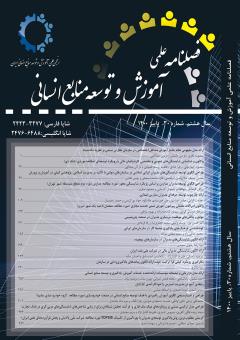گونهشناسی فرهنگهای یادگیری محیط کار در سازمانهای ایرانی
محورهای موضوعی : رویکرد ها ومدل های ظرفیت سازی منابع انسانی
سعید صفایی موحد
1
![]() ,
محمد حاجی زاد
2
,
محمد حاجی زاد
2
1 - شرکت ملی نفت ایران
2 - گروه علوم تربیتی، واحد نکا، دانشگاه آزاد اسلامی، نکا، ایران
کلید واژه: فرهنگ یادگیریمحیط کاریادگیری محیط کار,
چکیده مقاله :
هدف اصلی این پژوهش شناسایی انواع فرهنگهای یادگیری محیط کار در سازمانهای ایرانی میباشد. روش تحقیق گراندد تئوری از نوع کلاسیک است که توسط گلیزر مطرح شده است. برای جمع آوری دادهها، 98 نفر از کارکنان سازمانهای تولیدی، خدماتی و بازرگانی در سه بخش دولتی، خصوصی، و خصولتی در طول یک دوره 4 ساله مورد مصاحبه قرار گرفتند. مصاحبهها از نوع نیمهساختاریافته یا عمیق بود، به طوری که چند سوال کلی از تمامی شرکتکنندگان در پژوهش پرسیده شد و سوالات بعدی بر اساس شرایط مصاحبه و دادههای کسب شده مطرح میشدند. نمونهگیری در پژوهش حاضر به صورت هدفمند و با به کارگیری دو راهبرد نمونه گیری با حداکثر تنوع و نمونهگیری نظریهای انجام شده است. نهایتاً دادههای حاصل نیز به طور مستمر با استفاده از دو راهبرد بازبینی اعضاء و ممیزی همکاران اعتباربخشی شدند. تحلیل دادههای این پژوهش بر اساس چارچوب گراندد تئوری کلاسیک (گلیزی) در دو گام کدگذاری جوهری و کدگذاری نظریهای صورت پذیرفت. براساس تحلیلهای صورت گرفته، انواع فرهنگهای یادگیری در سازمانهای ایرانی به شرح ذیل می باشند: فرهنگ یادگیری بازدارنده، فرهنگ یادگیری جزمگرایانه، و فرهنگ یادگیری الزامآور. عوامل موثر در شکل گیری این فرهنگ ها را میتوان رویکرد مدیران، نگرشهای همکاران و انتظار نسبت به ارتقاء در محیط کار دانست.
This study aimed at identifying learning cultures in various workplaces through an emergent grounded theory study. To gather data, in-depth interviews were conducted on 98 employees of small to large companies to reach a vast breadth and depth of data. For purpose of inclusiveness, a maximum variation strategy was adopted for sampling to select participants purposively from manufacturing, business and service companies. The data were thematically analyzed at two levels, namely initial and secondary coding. To establish credibility, two dominant strategies were continuously used as member check and peer debriefing and external auditing. Consequently, a tripartite typology emerged to represent learning culture in various enterprises based on three criteria: management approach, peers' reaction, promotion expectancy. To sum up, in a malignant learning culture, bad working habits are learned and shared by staff, and commitment to work is gradually minimized to its lowest possible point. In a deterministic learning culture, a neutral learning climate dominates the workplace as staffs perceive no link between self-development and job promotion. Finally, in a demanding learning culture, people may clearly view the sensible link between competency development and job promotion, so they try their utmost to keep up with the latest developments in their field to avert the risk of demotion or job loss. The study suggests that if enterprises plan to achieve and keep a competitive edge, they should focus firmly on creating a demanding workplace learning culture.
1.Vaughan, Karen (2008). Workplace learning: a literature review. Competenz, New Zealand.
2. Billett, Stephen (2020). Workplace learning: its potential and limitations. Education and Training, 37(4): 20-27.
3. 3.Billett, Stephen (1996). Towards a model of workplace learning: The learning curriculum. Studies in Continuing Education, Vol 18(1): 43-58.
4.Billett, Stephen (2001). Learning in the workplace: Strategies for effective practice. ALLEN & UNWIN, CROWS Nest.
5.Billett, Stephen (2002). Towards workplace pedagogy: Guidance, Participation, and Engagement. Adult Education Quarterly, vol 53 (1): 27-A3.
6.Billett, Stephen (2005). Constituting the Workplace curriculum. Journal of Curriculum Studies, 37(3): 1- 15.
7.Fuller, Alison; Unwin, Lorna (2003). Learning as Apprentices in the Contemporary UK Workplace: Creating and managing expansive and restrictive participation. Journal of Education and work, vol: 16(4): A07-A26.
8.Utech, Jenny Lee (2008). Contextualized Curriculum for Workplace Education: An Introductory Guide, Massachusetts Department of Elementary and Secondary Education Adult and Community.
9 .Belfiord, Mary Ellen (1996). Understanding Curriculum Development in the Workplace: A Resource for Educators. ABC Canada.
10.Mulder, Hanneke; Cate, Oketen; Daalder, Rienke, Berkvens, Jasephine (2010). Building a competency-based workplace curriculum around trustable professional activities: The case of physician assistant training. Medical Teacher, 32: eA53-e459.
11.Matthews, Pamela (1999). Workplace learning: developing a holistic model. The Learning Organization, Vol: 6(1): 18-29.
12.Safaei Movahed, Saeid; Mohebbat, Hedieh (2012). Sociology of Education. AYIJ Publications, Tehran.
13.Schneider, Benjamin; Ehrhart, Markg; Macey, Willian H. (2013). Organizational climate and culture. The Annual Review of Psychology, 2013, 64: 367-388.
14.Marsick, Victoria J; Watkins, Karen (2003) Demonstrating the value of an organization’s learning culture: The Dimensions of the Learning Organization Questionnaire. Advances in Developing Human Resources, 2003, 5:132-151.
15.Breda- Verrduijn, Hester van; Heijboer, Marjoleine (2016). Leaning culture, continuous learning, and organizational learning anthropologist. Industrial and Commercial Training, Vol. 48(3): 123-128.


